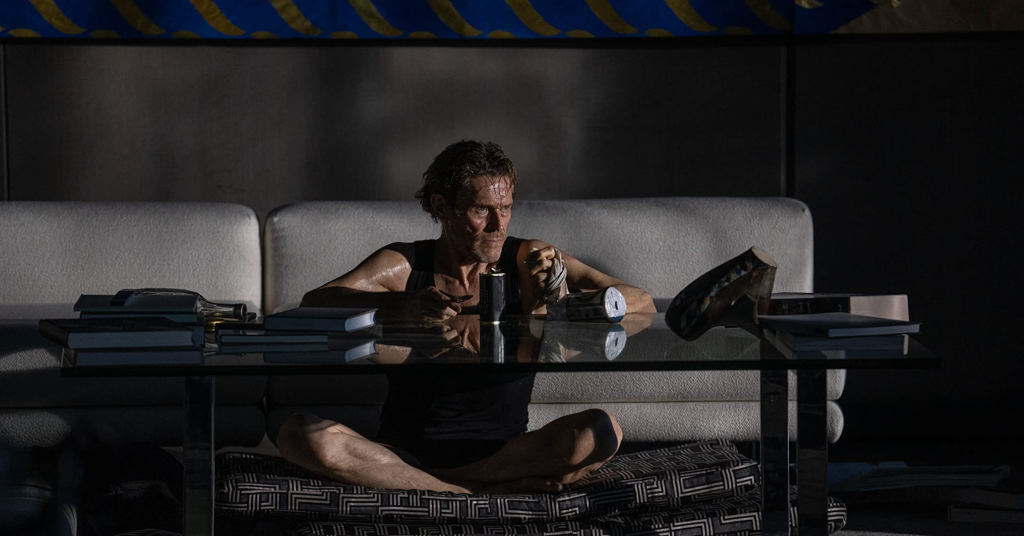It’s always a distinct pleasure to watch Willem Dafoe lose his mind. Whether he’s playing a schizophrenic supervillain or a neurotic lighthouse keeper, his demented expressions and wild mannerisms can equally inspire horror and hilarity.
Inside, the debut of director Vasilis Katsoupis, is predicated on the assumption that a fresh portrayal of declining sanity from Dafoe will be captivating enough in itself to sustain a feature-length film. Dafoe stars as Nemo, an art thief tasked with stealing a number of prized pieces from a luxury Manhattan penthouse. In the film’s opening moments, he infiltrates the apartment and gets to work, communicating via a walkie-talkie with an accomplice who’s seemingly brought down the building’s security systems. But the carefully planned heist implodes when an alarm suddenly rings out, sealing the windows and locking the enormous front door. Nemo scrambles for an exit, disoriented by the deafening wail and whirling lights, but he appears to be hopelessly stuck. “You’re on your own,” his partner informs him, before permanently hanging up.
And that’s not a figure of speech. Outside of a few brief dream sequences, Dafoe interacts with no other actors throughout the film’s moderately excessive 105 minute duration. His performance is the centerpiece of the modern art installation Katsoupis has constructed—a cold yet extravagant home that turns from its owner’s sanctuary into Nemo’s prison. The set design is dazzling and deliberate; careful thought was clearly placed into the layout of the vast apartment, which Nemo explores methodically as his plight grows increasingly desperate. It features such emblems of wealth as an interior pool, a movie theater, and a fridge that plays “Macarena” when it’s left open. But these luxurious qualities are offset by the jagged angles, empty space, or muted colors present in every room. There’s a deadening blandness lurking beneath the opulence, and it amplifies the pain Nemo endures as he adapts to a mundane and solitary new routine.
Once the alarm is disarmed, Nemo spends the remainder of the film attempting to escape the penthouse. He tries to break through the front door, but it ultimately can’t be pierced. The windows and walls are similarly resilient, and the maid who vacuums the outside hallway each day can’t hear him screaming for help. Eventually, he determines that the only way out is through a skylight that hangs far above the living room. To reach it, he comically fuses the methods of MacGyver and Wile E. Coyote, assembling a makeshift ladder of tables and chairs held together by straps. At the top, he slowly works to remove the bolts holding the skylight in place. As a substitute for protective goggles, he ties a length of rope around his head, fashions two eye holes, and fills each of them with a shard of glass from a broken vase. This process takes weeks; the passage of time is represented only by the growth of his hair and the evolving grime on a bathtub. And as the ordeal unfolds, Nemo’s isolation—compounded by a lack of food and water and a thermostat that keeps veering between extreme temperatures—threatens to push him over the edge of madness.
Dafoe is exceedingly assured here, and his masterful performance keeps the film engaging even when certain scenes begin to move with a creak. He groans and cackles, sprints and staggers. Sometimes, he’s reduced to an almost primal state, howling in despair or mumbling senselessly while cradling himself in his arms. In other moments, when a craving for freedom overtakes him, he vigorously bounces around his surroundings. It’s a role that requires him to embody almost every conceivable emotional state, and he accepts the challenge with brio. He conveys loneliness with palpable anguish, but when he leans into the sillier side of his burgeoning insanity—singing and dancing along to “Macarena” in one memorable instance—it’s impossible not to giggle.
Katsoupis’ treatment of Nemo’s struggle evokes European directors such as Haneke and Ostlund. Inside is characterized by rich lighting and voyeuristic cinematography, replete with detached shots of Dafoe and the apartment that linger on the screen. Occasionally, Katsoupis incorporates a few prosaic story elements that have become tired from their inclusion in countless psychological dramas—Nemo’s hunger forces him to consume dog food, and his isolation leads him to create a romantic fantasy involving the maid—but most of the film’s plot occurrences feel inspired rather than obligatory. Paintings that reflect Nemo’s difficulties adorn the penthouse’s walls. The literal significance of “Untitled,” Maurizio Cattelan’s 1999 piece, is obvious, but the other works on display are more symbolic, pointing to the deterioration of Nemo’s psyche rather than the physical restraints placed on him.
But although Inside is persistently intriguing and seldom dull, it never manages to transcend its concept. Throughout, it’s difficult to shake the feeling that Katsoupis’ ending will disappoint, and while the film’s climactic moments aren’t frustrating, they fail to provide enough thematic depth to elevate the experience. Katsoupis’ concerns are profoundly existential, but he merely raises philosophical issues without offering any meaningful insights into their complexities. Topics including the purpose of art, the relationship between creation and destruction, and man’s place in a chaotic world are all gestured toward with minimal exploration. Inside simply lacks the metaphorical substance to satisfy as anything more than a vehicle for Dafoe or a curious mood piece. Thankfully, the mood is viscerally realized, and Dafoe’s talents are such that the film amounts to a gripping experience despite its limitations.






Please note that we at The Dispatch hold ourselves, our work, and our commenters to a higher standard than other places on the internet. We welcome comments that foster genuine debate or discussion—including comments critical of us or our work—but responses that include ad hominem attacks on fellow Dispatch members or are intended to stoke fear and anger may be moderated.
With your membership, you only have the ability to comment on The Morning Dispatch articles. Consider upgrading to join the conversation everywhere.